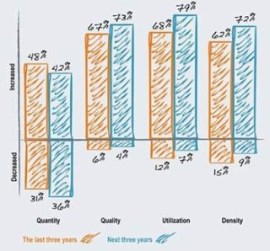by Shane Henson — November 6, 2013—Corporate real estate executives are increasingly finding themselves working side-by-side with colleagues, but not necessarily in a good way. New workplace research shows that 62 percent of corporate real estate executives have experienced increased workplace density globally during the past three years, making them crammed into the same space, or less space, according to global financial and professional services firm Jones Lang LaSalle (JLL).
According to the firm’s report, Global Corporate Real Estate Trends 2013 (GCRES), which measured survey insights from 630 corporate real estate executives in 39 countries, 80 percent of corporations expect to increase space utilization even more during 2013 to 2016.

As the graph shows, nearly 80 percent of corporations expect to increase space utilization even more during 2013 to 2016, which will make CRE execs feel even more crowded.
(Click on image to enlarge)
Based on the report’s findings, JLL says that corporate real estate executives need technological tools that support workplace strategic planning. Forty-six percent of GCRES respondents report a need for occupancy planning tools as critical for delivering workplace solutions and measuring productivity gains, JLL notes.
“Companies need to embrace a mix of solutions that include space inside the office, but that also go beyond the boundaries of the traditional corporate real estate portfolio,” said John Hampton, senior vice president of innovation and product development at JLL. “These solutions need to evolve beyond co-working and into viable proworking programs that reduce fixed-space commitments for the corporation, while providing workers with greater choice as to where they want or need to work.”
The need for tools that also support change management was echoed in the results of JLL’s “Proworking Poll.” The poll of 82 corporate real estate executives further underscores the challenges of implementing flexible work environments, as 42 participants rated the fear of internal resistance to change as their greatest burden.
The corporate unwillingness to change was evident from respondents that indicated companies are still tied to inefficient real estate models such as providing dedicated offices or cubes, home offices, or shared cubicles; yet zero percent offered a third place or co-working location for employees to work.
To give corporate real estate executives more breathing room and work space options, Hampton led the development of JLL’s new workplace strategy service called Space Exchange that addresses both the supply and demand pressures by adapting portfolio optimization and sharing economy principles to suit the needs of large enterprises. To learn more about JLL’s approach, watch the brief video summary.
“While many companies face barriers that impede the implementation of flexible work environments, 78 percent of our poll respondents said that it was important to create more workplace choices for their company in the next six months,” said Hampton. “The demand for tailored technology solutions like Space Exchange that applies the principles of shared space use to suit enterprise needs is quickly becoming a critical factor for a high-performance workplace.”





